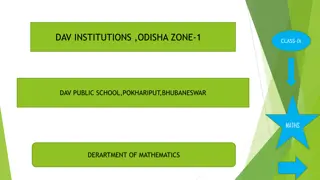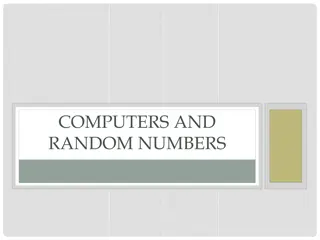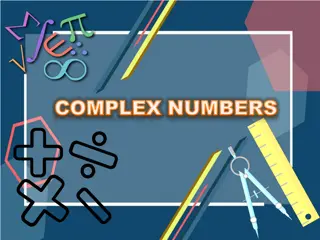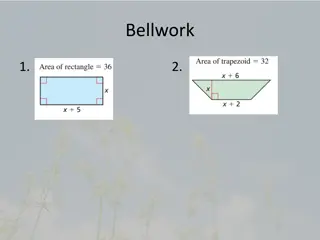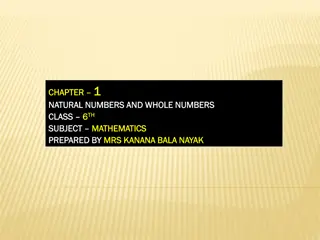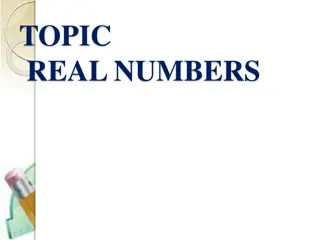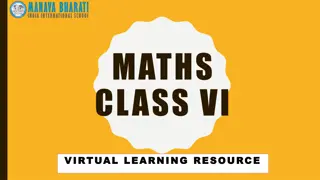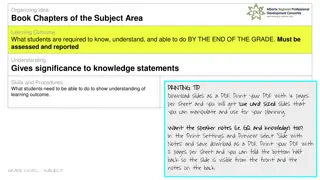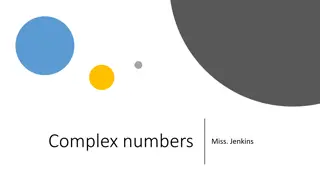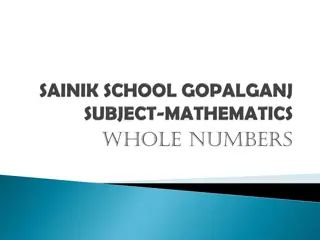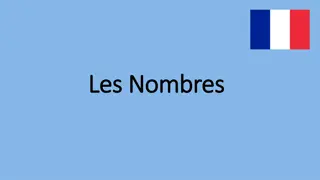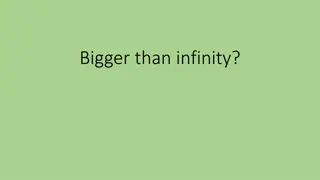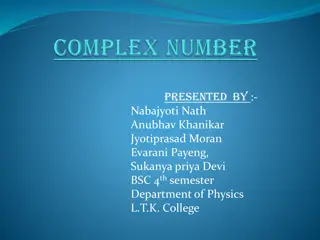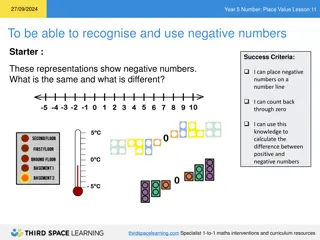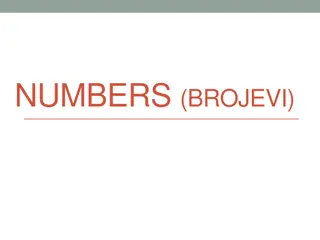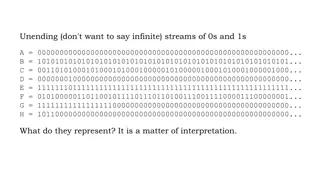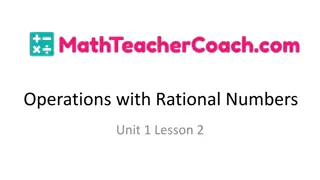Understanding Different Types of Numbers
Explore the various types of numbers such as odd, even, natural, prime, composite, factors, and multiples. Learn to identify these numbers, understand their properties, and practice sorting and matching them through engaging activities and worksheets.
Download Presentation

Please find below an Image/Link to download the presentation.
The content on the website is provided AS IS for your information and personal use only. It may not be sold, licensed, or shared on other websites without obtaining consent from the author. Download presentation by click this link. If you encounter any issues during the download, it is possible that the publisher has removed the file from their server.
E N D
Presentation Transcript
Title: Types of Numbers Look at the list of keywords. Which words are familiar to you? Mark the words with a Odd Number Even Number Natural Number Factor Highest Common Factor Multiple Lowest Common Multiple Prime Number Composite Number Twin Prime
Worksheet Activities Student worksheets can be printed prior to lesson. Worksheets aid the presentation. Checklist (Prior) Odd Even Numbers Factors Checklist (Prior) Odd & Even Numbers Factors Prime Numbers Highest Common Factor Lowest Common Multiple Prime Numbers Highest Common Factor Lowest Common Multiple Checklist (Post) Keywords/ Definitions Mix Match Checklist (Post) Keywords/ Definitions Mix & Match
Can you sort the numbers? 2, 19 , 17, 22, 5, 36, 33, 7, 1, 0, 12 100, 77, 89, 64, 1200, 131, 3, 52, 96, 9 ODD EVEN Click here for student worksheet. Click here for student worksheet.
Create your own definition for odd and even numbers ODD EVEN 2, 22, 36, 12, 100, 89, 64, 1200, 52, 96 19, 17, 5, 33, 7, 1, 77, 89, 131, 3, 9 HINT: 2
True/ False Odd Number + Odd Number = Even Number ODD A whole number which is not divisible by two. When divided by 2, the answer has a remainder. 19, 17, 5, 33, 7, 1, 77, 89, 131, 3, 9
True/ False Even Number + Even Number = Even Number EVEN 2, 22, 36, 12, 100, 89, 64, 1200, 52, 96 A whole number which can be divided by 2 with no remainder.
A Natural Number: A positive whole number. Natural numbers are denoted with the capital letter N Highlight the NATURAL NUMBERS on this number line.
Factors: Using the numbers given, match numbers into pairs that multiply together to give the following products below a) 63 b) 48 c) 36 d) 10 Click here for student worksheet. Click here for student worksheet.
Factors: Using the numbers given, match numbers into pairs that multiply together to give the following products below Create your own definition for the keyword FACTOR. xxxx a) 63 b) 48 c) 36 d) 10
Factor: A factor of a number divides exactly into that number, leaving no remainder. FALSE TRUE 4 is a factor of 20 3 is a factor of 34 1 is a factor of every number Every number is a factor of itself Another word for factor is DIVISOR The factors of 16 are 1,2,4,8,16 3 x 6 is a pair factor of 18
FALSE TRUE 4 is a factor of 20 3 is a factor of 34 1 is a factor of every number Every number is a factor of itself Another word for factor is DIVISOR The factors of 16 are 1,2,4,7,16 3 x 6 is a pair factor of 18 TRUE FALSE TRUE TRUE TRUE FALSE TRUE
Factors of 10 are _______________ Factors of 20 are _______________ Represent the above factors on the VENN DIAGRAM below
20 1 10 1 Hands up you got this VENN DIAGRAM 5 4 5 2 2 10 Factors of 20 Factors of 10
1 20 10 1 Hands up you got this VENN DIAGRAM 5 4 5 2 2 10 Factors of 20 Factors of 10
20 10 Hands up you got this VENN DIAGRAM 1 5 4 2 Factors of 20 Factors of 10
Which number is the Highest Common Factor? 20 10 1 5 The Highest Common Factor (HCF) is the highest factor common to both products. 4 2 Factors of 20 Factors of 10
Highest Common Factor (HCF): Factors of 56 1, 2, 4, 7, 8, 14, 28, 56 Factors of 48 1, 2, 3, 4, 6, 8, 12, 16, 24, 48 Factors of 36 1, 2, 3, 4, 6, 9, 12, 18, 36 Factors of 81 1, 3, 9, 27, 81 Factors of 144 1, 2, 3, 4, 6, 8, 9, 12, 16, 18, 24, 36, 48, 72, 144 8 1. What is the HCF of 56 and 48? 2. What is the HCF of 48 and 144? 3. What is the HCF of 36, 81 and 144? 4. What is the HCF of 144, 56 and 48? 5. What is the lowest common factor of 56 and 36? 6. TRUE/FALSE Is the lowest common factor always ONE? 48 9 8 1 TRUE Click here for student worksheet. Click here for student worksheet.
Multiple: is the number we get when we multiply a given number by a whole number. Multiple: Look at the table and explain what a multiple is. 1 2 3 4 5 6 7 8 9 10 11 12 1 2 3 4 5 6 7 8 9 10 11 12 2 4 6 8 10 12 14 16 18 20 22 24 3 6 9 12 15 18 21 24 27 30 33 36 4 8 12 16 20 24 28 32 36 40 44 48 5 10 15 20 25 30 35 40 45 50 55 60 6 12 18 24 30 36 42 48 54 60 66 72 7 14 21 28 35 42 49 56 63 70 77 84 8 16 24 32 40 48 56 64 72 80 88 96 9 18 27 36 45 54 63 72 81 90 99 108 10 20 30 40 50 60 70 80 90 100 110 120 11 22 33 44 55 66 77 88 99 110 121 132 12 24 36 48 60 72 84 96 108 120 132 144 Click here for student worksheet. Click here for student worksheet.
Lowest Common Multiple (LCM): The Lowest Common Multiple is the smallest number common in both multiples of a given number. 1 2 3 4 5 6 1 2 3 4 5 6 2 4 6 8 10 12 3 6 9 12 15 18 4 8 12 16 20 24 Q1. What is the LCM of 4 and 2? Q2. What is the LCM of 4 and 5? Q3. What is the LCM of 3, 5 and 6? Q4. What is the LCM of 2, 3 and 5? Q5. What is the LCM of 6 and 8? Q6. What is the LCM of 8 and 16? Q7. TRUE / FALSE You always get a common multiple of a pair of numbers by multiplying them together. Q8. Why have I not asked you to find the Highest Common Multiple yet? 4 5 10 15 20 25 30 20 6 12 18 24 30 36 30 30 7 14 21 28 35 42 8 16 24 32 40 48 9 18 27 36 45 54 10 20 30 40 50 60 11 22 33 44 55 66 12 24 36 48 60 72 Click here for student worksheet. Click here for student worksheet.
Lowest Common Multiple (LCM): The Lowest Common Multiple is the smallest number common in both multiples of a given number. Q5. What is the LCM of 6 and 8? Multiplies of 6 = 6, 12, 18, 24, 30, 36, 42, 48, 54, 60 Multiples of 8 = 8, 16, 24, 32, 40, 48, 56, 64, 72, 80, 88, 96 The Lowest Common Multiple (LCM) is 24 Q6. What is the LCM of 8 and 16? Multiples of 8 = 8, 16, 24, 32, 40, 48, 56, 64, 72, 80, 88, 96 Multiples of 16 = 16, 32, 48, , 64, 80, 96 The Lowest Common Multiple (LCM) is 16 Q7. TRUE / FALSE You always get a common multiple of a pair of numbers by multiplying them together. TRUE Q8. Why have I not asked you to find the Highest Common Multiple yet? You could be multiplying for quite a while.
Prime Numbers: A number with 2 factors only. Exception: 1 is not a Prime Number. 1 2 3 4 5 6 7 8 9 10 11 12 13 14 15 16 17 18 19 20 21 22 23 24 25 26 27 28 29 30 31 32 33 34 35 36 37 38 39 40 41 42 43 44 45 46 47 48 49 50 51 52 53 54 55 56 57 58 59 60 61 62 63 64 65 66 67 68 69 70 71 72 73 74 75 76 77 78 79 80 81 82 83 84 85 86 87 88 89 90 91 92 93 94 95 96 97 98 99 100 Click here for student worksheet. Click here for student worksheet.
1 2 3 4 5 6 7 8 9 10 11 12 13 14 15 16 17 18 19 20 21 22 23 24 25 26 27 28 29 30 31 32 33 34 35 36 37 38 39 40 41 42 43 44 45 46 47 48 49 50 51 52 53 54 55 56 57 58 59 60 61 62 63 64 65 66 67 68 69 70 71 72 73 74 75 76 77 78 79 80 81 82 83 84 85 86 87 88 89 90 91 92 93 94 95 96 97 98 99 100 PRIME NUMBERS COMPOSITE NUMBERS What is the ONLY even PRIME number between 1 - 100?
1 2 3 4 5 6 7 8 9 10 3 and 5 11 12 13 14 15 16 17 18 19 20 21 22 23 24 25 26 27 28 29 30 11 and 13 31 32 33 34 35 36 37 38 39 40 41 42 43 44 45 46 47 48 49 50 17 and 19 51 52 53 54 55 56 57 58 59 60 41 and 43 61 62 63 64 65 66 67 68 69 70 71 72 73 74 75 76 77 78 79 80 71 and 73 eee 81 82 83 84 85 86 87 88 89 90 91 92 93 94 95 96 97 98 99 100 Identify the Twin Prime Numbers: Two prime numbers have one or two composite numbers between them PRIME NUMBERS COMPOSITE NUMBERS
Steps to finding the Prime Numbers between 1 100: 1. Colour in number 1 as this is NOT a Prime Number. 2. Number 2 is a Prime Number. Do not colour in number 2. Colour in ALL the multiples of 2. 1 2 3 4 5 6 7 8 9 10 11 12 13 14 15 16 17 18 19 20 21 22 23 24 25 26 27 28 29 30 3. Number 3 is a Prime Number. Do not colour in number 3. Colour in ALL the multiples of 3. 31 32 33 34 35 36 37 38 39 40 41 42 43 44 45 46 47 48 49 50 51 52 53 54 55 56 57 58 59 60 4. Number 5 is a Prime Number. Do not colour in number 5. Colour in ALL the multiples of 5. 61 62 63 64 65 66 67 68 69 70 71 72 73 74 75 76 77 78 79 80 81 82 83 84 85 86 87 88 89 90 5. Number 7 is a Prime Number. Do not colour in number 7. Colour in ALL the multiples of 7 . 91 92 93 94 95 96 97 98 99 100 Note: We are colouring in all the numbers which ARE NOT Prime Numbers. Numbers left uncoloured will be the PRIME NUMBERS
With your prime numbers at hand, what do the following numbers have in common? 25 51 77 7 x 11 3 x 17 5 x 5 Hint: What is a Prime Factor?
Mix and Match Activity. Access worksheet by clicking on this link: https://www.scoilnet.ie/search/resource/entity/sh ow/Lre/24018/
Reflection: Review the keywords by completing the table Homework: Odd Number Students should complete middle section of this sheet. Even Number Natural Number Factor Highest Common Factor Multiple Lowest Common Multiple https://www.scoilnet.ie/search/resource/ entity/show/Lre/22750/ Prime Number Composite Number Twin Prime Prime Factor Click here for student worksheet. Click here for student worksheet.
Extension Work Research the meaning of each keyword below, create a class activity to help explain three of the keywords: Consecutive Number Perfect Number Rational Number Integer Faction Decimal Square Root Power Product Couple, Dozen , Bakers Dozen, Score, 12 Dozen, Gross, Great Gross Decade, Century, Millennium, Single, Double, Triple, Quadruple, Quintuple, Hexatruple, Septuple . Centuple.




